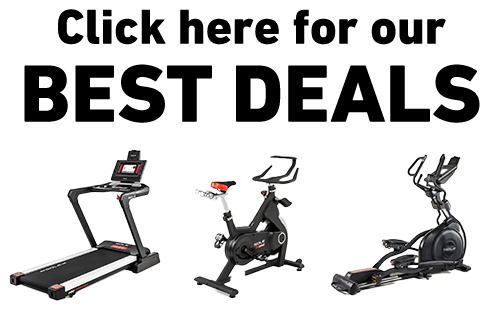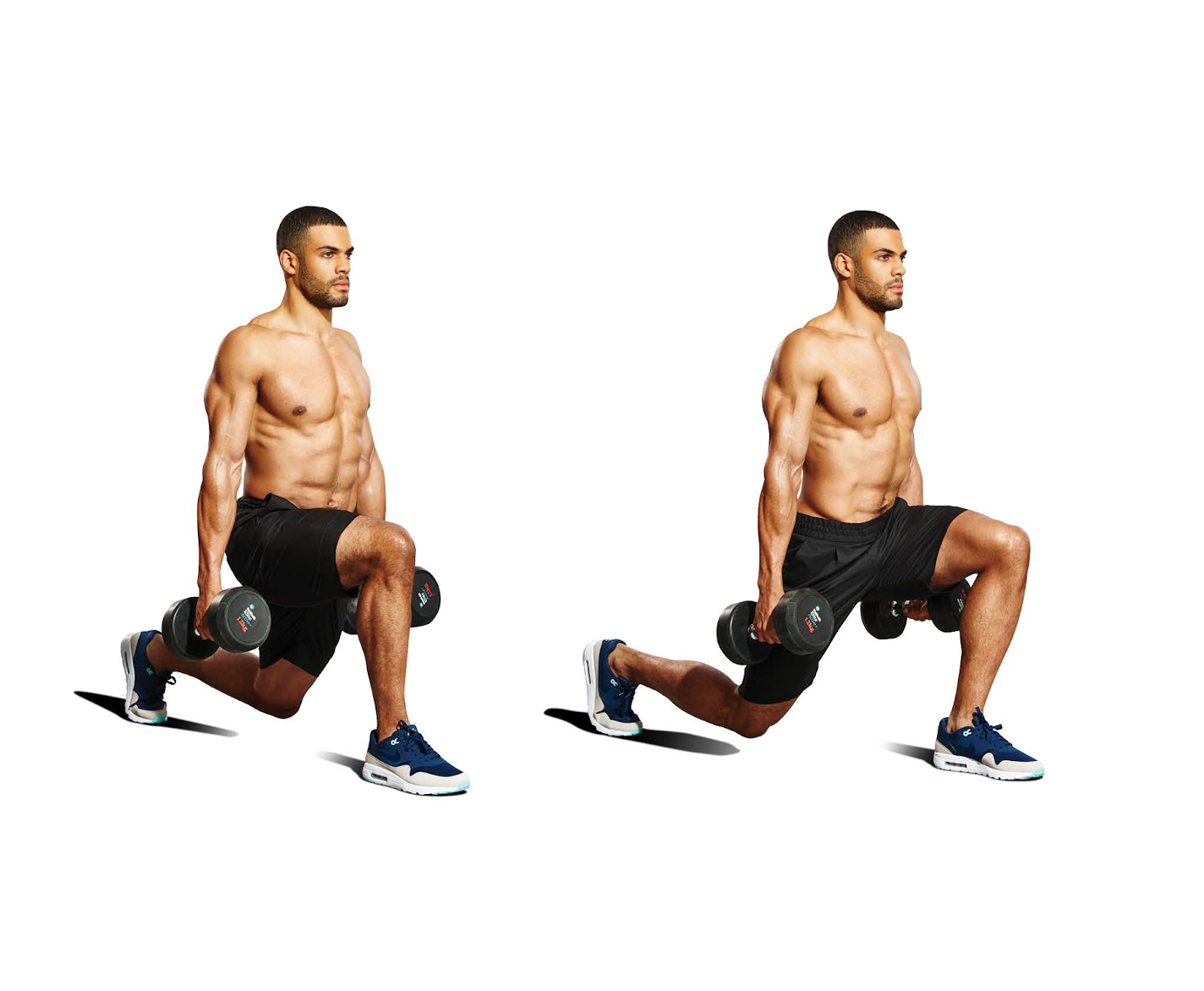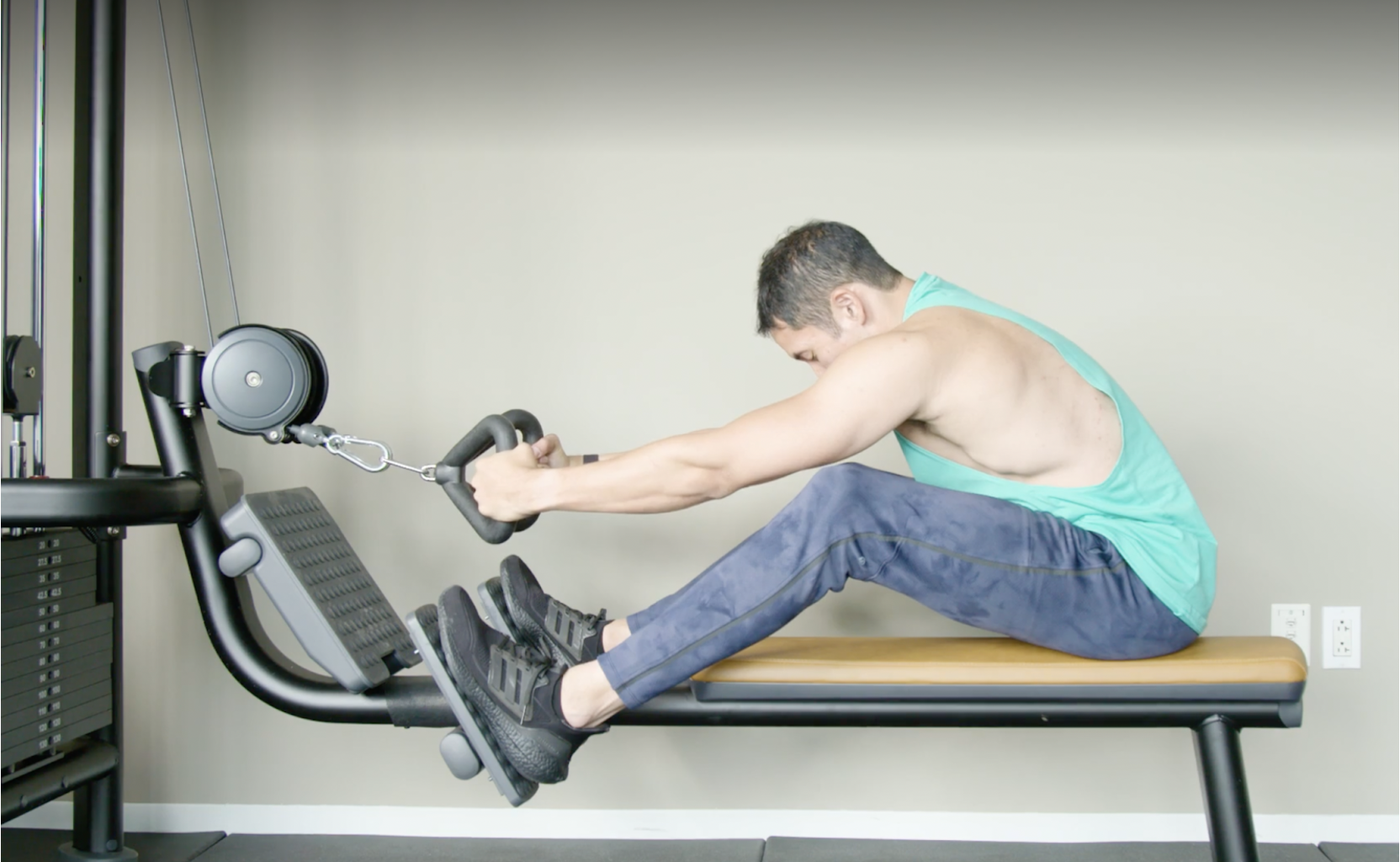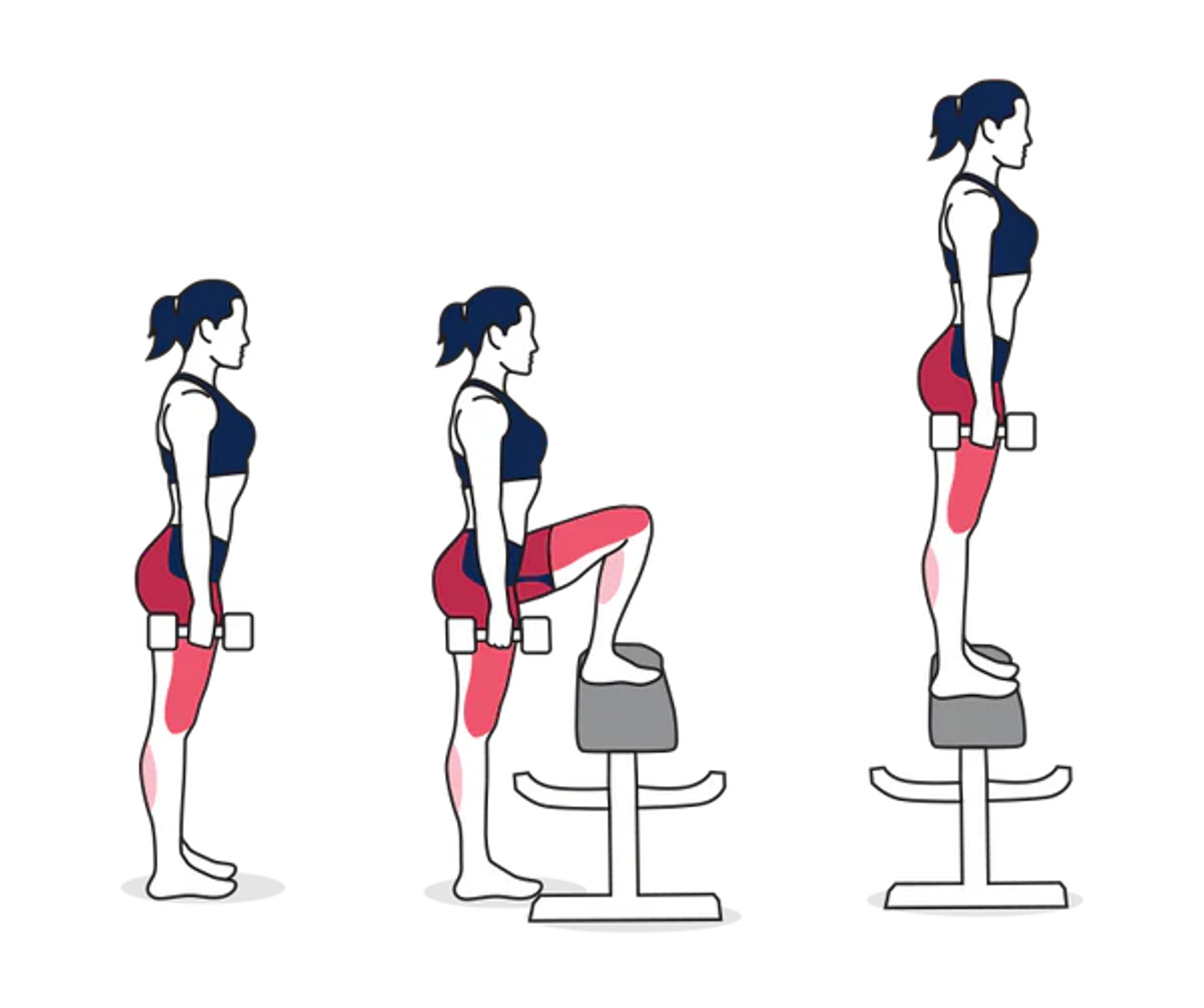Key Takeaways
- Step ups are great for quads, lunges are better for glutes, but it depends on your goals.
- Both exercises build functional strength you'll use in everyday life and athletic performance.
- Step ups are easier on your knees, perfect for beginners or if you have knee issues.
- Lunges give you more range of motion and tons of variations like walking, reverse, and lateral lunges.
- SOLE adjustable dumbbells eliminate the need for multiple weight sets when training step ups and lunges.
Step Ups vs Lunges
At their core, step ups and lunges are compound movements that train multiple muscle groups simultaneously. They both qualify as unilateral exercises, meaning they work one leg at a time, which helps correct muscle imbalances and improve stability. However, the mechanics behind each exercise create different emphasis points that can dramatically affect your training outcomes.
Step ups involve elevating your body by stepping onto a raised platform, primarily emphasizing vertical movement against gravity. This creates significant quadriceps engagement with secondary activation of the glutes and hamstrings.
Lunges, on the other hand, involve a forward, backward, or lateral stride that creates a more horizontal force vector, often resulting in greater glute and hamstring recruitment due to the hip extension demands. The split stance in lunges also introduces greater stability challenges and deeper hip flexion than experienced in step ups.
|
At SOLE, we're proud to offer top-quality exercise equipment designed for home and gym use. Our machines are built to meet the highest standards of durability and performance, making them ideal for fitness enthusiasts at any level. SOLE Products
|
Step Ups Explained
Step ups are a functional movement pattern that mimics the everyday action of climbing stairs while providing significant strength and stability benefits. The exercise involves stepping onto an elevated surface, fully extending the hip and knee of the working leg, and then returning to the starting position.
While it might look simple, step ups develop eccentric strength as you lower your body back to the starting position, which is crucial for athletic performance and injury prevention. (Image courtesy of Inspire US)
Proper Form
- Start by standing facing a sturdy bench, box, or platform that positions your knee at approximately 90 degrees when your foot is placed on top.
- Place your entire foot on the step, keeping your chest up and core engaged.
- Drive through your heel to lift your body up until your working leg is fully extended, bringing the opposite foot to tap the platform or stand completely.
- Control your descent by slowly lowering your body back to the starting position.
- Avoid pushing off with your back foot, which reduces the work of the target leg, and resist the temptation to lean forward excessively, which can strain your lower back.
Muscles Worked
- Quadriceps (primary): vastus medialis, vastus lateralis, vastus intermedius, rectus femoris
- Gluteal muscles: gluteus maximus (hip extension), gluteus medius/minimus (hip stabilization)
- Hamstrings: biceps femoris, semitendinosus, semimembranosus
- Calves: gastrocnemius, soleus
- Core muscles: transverse abdominis, erector spinae, obliques
Major Benefits
- Functional: They're like real-life movements (stairs, hiking)
- Fix imbalances: Each leg works separately
- Knee-friendly: Less stress than many other leg exercises
- Build balance: Great for coordination
- Minimal equipment: You just need something sturdy to step on
- Power development: Do them explosively for athletic training
Popular Variations
The basic step up can be modified in numerous ways to target different muscle groups or increase challenge.
- Lateral step ups: Step sideways to work outer glutes more
- Crossover step ups: Step diagonally to hit different hip muscles
- Deficit step ups: Start with back foot lower for a bigger range of motion
- Power step ups: Add a hop at the top to build explosive strength
- Weighted step ups: Hold dumbbells or use a barbell
- Slow tempo: Take 3–5 seconds to lower and build more muscle
Lunges Breakdown
Lunges are the Swiss Army knife of leg exercises. You can do them forward, backward, or sideways, and each version hits your muscles differently. They're tougher on balance but amazing for overall leg development.
What sets lunges apart is their ability to train the body through multiple planes of motion, depending on the variation chosen. This multi-planar training develops more complete lower body strength and better prepares the body for real-world movements that rarely happen in just one dimension. The lunge pattern also creates significant stretch in the hip flexors of the rear leg, making it valuable for counteracting the tightness that often develops from prolonged sitting.
Unlike some lower body exercises that primarily load the spine vertically, lunges distribute load differently through the body, often making them more accessible for those with lower back concerns. (Image courtesy of Men’s Health)
Correct Technique
- Start with feet hip-width apart
- Step forward about 2–3 feet (the distance varies based on your height)
- Lower until both knees are at 90 degrees
- Front knee stays over ankle (not past toes) to protect the joint
- Back knee drops toward floor but doesn't touch
- Push through front heel to return
Common form mistakes include:
- Allowing the front knee to cave inward (valgus collapse).
- Leaning the torso too far forward.
- Taking too short a stride which places excessive stress on the knees.
- Focusing on pushing through the heel of your front foot when returning to the starting position, which maximizes glute engagement.
- Keeping your core braced throughout the movement and avoiding excessive forward lean to protect your lower back.
- For beginners, performing lunges next to a wall or sturdy surface for balance assistance can help develop proper technique before progressing to unsupported variations.
Muscle Activation
Primary movers:
- Glutes, especially during the push back up
- Quads are worked hard throughout
- Hamstrings help control the descent and help you stand
Stabilizers:
- Core, which keeps you upright
- Hip stabilizers, which prevent wobbling
- Calves maintain your balance
- Inner thighs help control the movement
Key Advantages
- Athletic carryover: Great for sports with direction changes
- Fix imbalances: Each leg works independently
- Hip mobility: Counteracts tight hips from sitting
- Cardio bonus: High reps get your heart pumping
- Variety: There’s a lot of ways to do them
- Glute builder: Especially reverse lunges
Different Types
- Forward lunges: Standard version, quad-focused
- Reverse lunges: Step backward, easier on knees, more glute work
- Walking lunges: Keep moving forward, great cardio
- Lateral lunges: Step sideways, works inner/outer thighs
- Curtsy lunges: Step back and across, targets outer glutes
- Split squats: Stationary version, really focus on form
- Bulgarian split squats: Back foot elevated, super intense
Glute Development Face-Off
Let's get to what many of you really want to know: which exercise builds a better butt?
Your glutes are your body's biggest muscle group. Both exercises work them, but differently. The key is hip extension; the deeper you go and the more you extend at the top, the more glute activation you get.
Your glutes, comprising the gluteus maximus, medius, and minimus, are the largest muscle group in your body and play a critical role in everything from athletic performance to posture and daily function. Both exercises effectively target these muscles, but they do so through different mechanisms and with varying degrees of activation.
Research shows that the hip extensions of both movements are what primarily drives glute engagement. The deeper the hip flexion at the bottom position and the more complete the extension at the top, the greater the potential glute activation. This is where lunges often gain an edge. The longer stride length typically creates more hip flexion and extension, particularly in variations like reverse lunges and walking lunges with an exaggerated step.
However, step ups shouldn't be underestimated. By increasing step height and focusing on a powerful hip extension at the top of the movement, you can dramatically increase gluteal recruitment.
The key difference is that lunges often create more horizontal force (especially in the return phase), while step ups emphasize vertical force, which can affect which portions of the gluteal musculature receive the greatest stimulus.
EMG Study Results
Electromyography (EMG) studies measuring muscle activation have shown that:
- Forward lunges activate glutes about 36% more than basic step ups
- Reverse lunges only beat step ups by about 18%
- BUT increase step height and step ups catch up fast
- Add weight to either exercise and glute activation shoots up
The takeaway: it's less about which exercise and more about HOW you do it.
Activation Patterns
Lunges:
- Glutes work through a bigger range of motion
- More stretch at the bottom equals more muscle activation
- Side and curtsy lunges hit the side glutes hard
Step ups:
- More focused glute work at specific points
- Less compensation from other muscles
- Easier to feel the glutes working
Range of Motion
Range of motion significantly impacts the effectiveness of both exercises for glute development. Lunges allow for greater hip flexion in the bottom position, especially in deeper lunge variations, which places the gluteus maximus under greater stretch before contraction. This stretch-shortening cycle can enhance the muscle's ability to generate force and potentially stimulate greater hypertrophy through what exercise scientists call "active insufficiency."
Step ups offer a more customizable range of motion through adjustments to step height. A higher step creates greater hip flexion and a more extensive range for the glutes to work through. However, even with a tall box or bench, step ups rarely match the deep hip flexion possible in lunges, particularly for individuals with good mobility.
This difference in range of motion means that lunges often create more mechanical tension throughout the gluteal muscles, a key factor in stimulating muscle growth.
That said, the more controlled nature of step ups allows for better isolation of the gluteal muscles with less compensation from other muscle groups, which can be beneficial for those specifically targeting glute development with precision.
The ability to focus on the mind-muscle connection is sometimes easier with step ups due to their more stable positioning. (Image courtesy of Inspire US)
Which Exercise Wins?
There's no universal winner. It depends on YOU:
For Beginners
Start with step ups since they:
- Are more stable (the box isn't going anywhere)
- Are easier to learn
- Are adjustable in difficulty (just change box height)
- Require less balance
Once you nail step ups, progress to split squats, then full lunges.
For Knee Health
Step ups are usually better:
- Less knee stress
- You control the range of motion
- Closed-chain exercise (foot stays planted)
If you do lunges with knee issues:
- Try reverse lunges (easier on knees than forward)
- Keep perfect form
- Don't let knee go past toes
For Muscle Growth
Want bigger muscles? Do both:
- Heavy step ups (6–8 reps) for strength
- Moderate-weight lunges (8–12 reps) for size
- Mix up variations to hit all angles
Lunges give more overall muscle tension through a bigger range of motion. Step ups are killer for quads, especially with a high box.
For Functional Strength
This depends on what "functional" means to you:
- Step ups: Better for climbing, hiking, vertical jumps
- Lunges: Better for sports, direction changes, sprinting
Build Powerful Legs at Home with SOLE Equipment
SOLE adjustable dumbbells and equipment mat create the perfect setup for both step ups and lunges, giving you everything needed to build strong, athletic legs without a gym membership.
You don't need a fancy gym to build legs that turn heads and perform even better. The SOLE SW155 and SW180 Adjustable Dumbbells are perfect for adding resistance to both step ups and lunges. You might need 40 pounds for step ups but only 20 for walking lunges; with fixed dumbbells, you'd need multiple pairs cluttering your space. The SW180s adjust from 5 to 80 pounds in seconds, growing with you as you get stronger.
The beauty of these dumbbells for single-leg work is the balanced weight distribution. When you're already challenging your stability with lunges or step ups, the last thing you need is wobbly weights throwing you off balance. SOLE's precise engineering means the weight stays stable in your hands, letting you focus on the movement, not fighting your equipment.
For all those lunge variations, the SOLE Equipment Mat is essential. At 36.5" x 78", you've got plenty of room for walking lunges, reverse lunges, or lateral lunges without running out of space. The non-slip surface keeps you planted during explosive movements, while the cushioning protects your knees if they touch down during lunges.
Here's a pro tip: the SW116 Weight Bench isn't just for upper body work. It's perfect for Bulgarian split squats. Just elevate your back foot on the bench and prepare for a glute burn like no other. With 9 adjustable positions, you can find the perfect height for your body proportions. The 550-pound capacity means it won't budge even during your most intense sets.
The SOLE+ App is fully included and has workout programs that show proper form for both exercises. You'll learn the subtle technique points that maximize muscle activation while keeping your joints happy. No more guessing if you're doing it right; you'll have expert guidance right in your pocket.
Frequently Asked Questions (FAQs)
Can I do step ups without equipment?
Absolutely! Step ups require minimal equipment, all you need is a stable elevated surface. A sturdy bench, box, or even a stair step in your home works perfectly. For beginners, a lower step height of 6–12 inches is ideal, while more advanced trainees might use heights of 18–24 inches for greater range of motion.
Just Make sure that whatever surface you use is completely stable and can support your full body weight without wobbling. Parks often have benches or platforms that work well for outdoor training, and most hotels have at least a chair or bench that can be used while traveling, making step ups one of the most accessible lower body exercises available.
Are lunges bad for knees?
Lunges aren't inherently bad for knees when performed with proper form, but technique matters tremendously. The most common problem is allowing the front knee to travel too far forward beyond the toes, which increases patellofemoral stress. Focus on taking a long enough stride that allows your front knee to track directly over your ankle when you descend. If you have existing knee issues, reverse lunges create less anterior knee stress than forward variations and might be a better option.
How often should I train glutes?
For optimal glute development, training frequency should balance sufficient stimulus with adequate recovery. Most research suggests that training the glutes 2–3 times per week provides the best results for most individuals. This frequency allows for enough volume to stimulate growth while providing sufficient recovery between sessions.
Can step ups replace squats?
While step ups are an excellent exercise, they shouldn't completely replace squats for most trainees. These exercises create different loading patterns and stress the muscles in complementary ways. Squats load the spine axially and create bilateral force production, developing systemic strength that step ups can't fully replicate. However, for individuals with certain back issues or those who cannot tolerate spinal loading, properly loaded step ups can serve as a primary lower body exercise that still delivers significant strength and hypertrophy benefits.
My grip gives out before my legs during weighted lunges, any solutions?
This is actually super common and where the SOLE SW180 Adjustable Dumbbells really shine. Its ergonomic handles distribute weight evenly across your palms, reducing those hot spots that kill your grip during longer sets. But here's the real game-changer: because you can adjust weights so quickly, you can do mechanical drop sets. Start with heavier weight for 8 reps, then when your grip starts failing, quickly drop to a lighter weight and keep going. Your legs get the full workout without your grip being the limiting factor.







Leave a comment
This site is protected by hCaptcha and the hCaptcha Privacy Policy and Terms of Service apply.